Harnessing Data and Digital Solutions to Improve Maternal Health
Digital technology is revolutionizing health care – enabling faster, data-driven decisions about how to provide care for more people as effectively as possible. Within the maternal health field, program implementers are increasingly integrating telemedicine, mHealth (mobile health), Artificial Intelligence (AI) and data analytics to deliver personalized support and tailored services for pregnant women, expand the reach of health providers and strengthen the resilience of local health systems. By capturing and analyzing real-time data throughout a woman’s pregnancy journey, health leaders are becoming more strategic about how to improve the efficiency and quality of maternal health services – ultimately helping reduce maternal mortality and morbidity.
Investing in digital tools and harnessing the power of data have enormous potential to overcome gaps in care and accelerate progress towards a world where no woman dies giving birth.
| Read more about the Strengthening Systems for Safer Childbirth initiative and all six of its locally-led coalitions. |
Increasingly, innovators in low- and middle-income countries (LMICs) are prioritizing data-driven solutions as part of their efforts to achieve better maternal health outcomes. Strengthening Systems for Safer Childbirth is an initiative supporting locally-led coalitions working to improve access to high-quality, respectful maternal health care in Kenya, Nigeria, India and Sierra Leone. With funding from MSD for Mothers, six multi-sector coalitions – composed of leading health care businesses, non-governmental organizations, technology companies, advocacy groups and national and local government entities – are strengthening health systems to support safer childbirth.
These coalitions are using a variety of data-driven digital technologies to enhance access to and utilization of maternal health services within local communities – while keeping women’s needs front and center. The solutions are varied and range from mHealth technologies that augment the capacity of overburdened health care workers to a data dashboard that guides government decisions about resource allocations.
Adopting mHealth tools to help women in Kenya receive the care they need
In Kenya, inadequate care during childbirth is responsible for more than half of the country’s maternal deaths in health facilities. A lack of sufficient data on women’s experience of care has hindered the Kenyan government’s ability to direct limited resources to where they are needed most and address gaps in the quality of maternal care. In response, Kenya Quality Ecosystem (KQE) – a coalition led by Jacaranda Health and ThinkWell– is collaborating with the governments in Makueni, Kisii and Mombasa counties to use feedback from women and their health providers to guide improvements in maternal and newborn health services. Already, the team is witnessing remarkable impact from 29% decline in facility-based maternal mortality in both Kisii and Makueni counties; and 45% increase in the maternal, newborn and child budget allocation in Makueni county.
Jacaranda Health launched PROMPTs – an AI-powered digital health service that sends women text messages about care throughout their pregnancy, nudges them to seek care according to their stage of pregnancy, asks them about their care experience and responds to their questions. An AI-enabled “help desk” triages the questions received based on level of risk with any question suggesting a potential need for review by a healthcare professional appropriately referred. Low risk questions (e.g., asking about basic health information) receive a response from the AI chatbot while women who ask high-risk questions (e.g., asking about worrisome symptoms, such as bleeding) are connected immediately to a health care provider.
KQE analyzes anonymized data from PROMPTS to understand whether women are receiving care at the right time and their perspectives on the quality of this care. The coalition then aggregates these insights to inform quality improvement efforts.
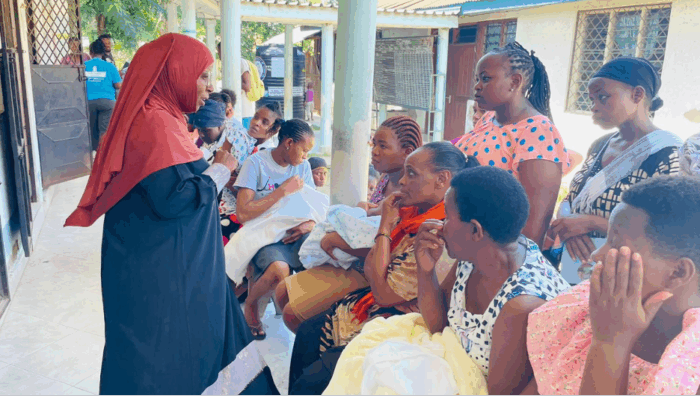
The KQE coalition is also supporting the delivery of high-quality maternal health care by upskilling frontline workers. KQE provides in-person training on emergency obstetric and newborn care through a mentorship model – identifying providers who become trainers as well as champions for quality maternity care and share their knowledge within their respective facilities. The in-person training is supplemented by a mHealth tool that offers support via WhatsApp. This combination of “training the trainers” and technology is accelerating scale and sustainability.
At the same time, KQE is identifying potential gaps in individual health provider’s knowledge and health facilities’ ability to deliver lifesaving care which, in turn, is informing where to focus training efforts to continuously improve the quality and timeliness of emergency maternal and newborn care.
Across Makueni, Kisii and Mombasa counties, KQE has reached nearly 60,000 women and 4,000 providers with impressive results:
- 20% increase in women attending four or more antenatal care visits
- 90% of high-risk women flagged by PROMPTS have received care at a hospital
- 87% of nurses participating in the mentorship program reported improved confidence and competence to manage childbirth emergencies
Using data insights to guide resource allocations
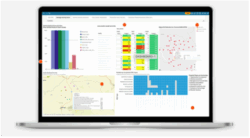
The data that KQE is capturing and analyzing from women and health providers have been valuable in informing quality improvement efforts. To deliver this information in an easy-to-understand and actionable way, KQE partnered with government agencies and local health facilities to create PULSE, a digital dashboard that helps decision-makers stay “on the pulse” of health care gaps and provides direction for improving maternal health services.
The dashboard triangulates the experience of care into a simple format, using a traffic light system that facilitates rapid identification of the “red flags” potentially hindering timely, quality maternal care. For example, women used PROMPTS to flag that there were long wait times at hospitals in Makueni county. Hospital leaders in the county saw this “alert” on the dashboard and responded by hiring nurses to address the staffing shortage – ultimately reducing wait times and improving women’s experience of care.
PULSE dashboards are growing in popularity and have been incorporated into health decision-makers’ routine meetings with both private and public health facilities and government leaders to monitor performance improvement. By coupling ThinkWell’s financing expertise with insights from this innovative management tool, health facility and government leaders are now allocating limited resources more strategically to improve the quality of maternal care.
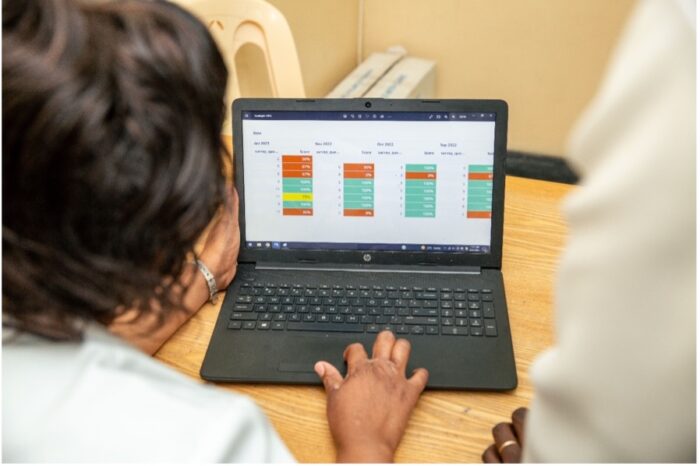
Since the dashboard was launched, 18 of Kenya’s 47 county governments have been accessing it more than 400 times per week on average and meeting frequently to assess and respond to the data. The dashboard has provided country health system managers with the evidence they need to advocate for more resources and has contributed to marked improvements in maternal health outcomes and increased financial investments in health:
- 29% decline in facility-based maternal mortality in both Kisii and Makueni counties
- 26% decline in facility-based neonatal mortality in Mombasa county
- 45% increase in the maternal, newborn and child budget allocation in Makueni county
- 33% increase in the overall health budget in Mombasa
Enhancing the capacity and reach of the health workforce in India
India is a hotbed of innovation and digital tools have become a vital part of the country’s response to maternal health challenges in different regions. Although at a national level, India’s maternal outcomes have been improving, strained local public health systems and women’s lack of agency in their own health care often produce poor outcomes among underserved segments of the population. These issues are especially acute in Madhya Pradesh and Assam, the states with the first and second highest maternal mortality ratios in the country.
e-SAATHI, a coalition led by Population Council Consulting, Sitaram Bhartia Institute and Nivi (a digital health company), is deploying an AI-enhanced mobile chatbot that is successfully complementing the role of health workers in both states. By sending periodic messages throughout pregnancy and the postpartum period, the chatbot nudges women to seek and reach appropriate health care. It prompts and supports women to seek antenatal care and to provide feedback on their experience. These digital capabilities are proving to be important in optimizing an overstretched workforce.
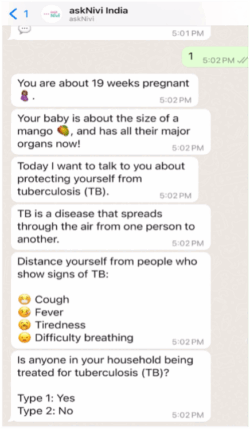
Leveraging WhatsApp, which is widely available, the askNivi chatbot provides women with information about maternal health, vaccinations and other primary health topics, encouraging them to take action and visit health services. The goal is to reach, understand and support women as they make critical decisions about their health while also augmenting health provider capacity.
e-SAATHI introduces women to AskNivi through digital ads on social media and at nearly 200 health care facilities where participating providers actively register women. Once a woman is on the platform, the chatbot provides her with personalized information about her pregnancy based on her expected due date. For example, she receives guidance on self-care, including wellness, nutrition and perinatal exercise. The chatbot also encourages her to attend each antenatal care check-up and sends reminders for both antenatal and postpartum care visits.
AI has helped women better navigate their maternal health journey, offering more flexibility at every stage from health education to services while ensuring that the data from individual women are protected by robust privacy and security measures.
Through the e-SAATHI coalition, askNivi has supported over 100,000 users in Assam and Madhya Pradesh with encouraging results:
- 99% of women reached reported that they had never received maternal health education via phone messages before and lacked effective alternatives
- 80% of women reported feeling very confident and empowered to make health care decisions for themselves after using askNivi
- 15% increase in utilization of antenatal care services in the communities served after askNivi was deployed
Leveraging real-time data insights to inform quality improvement efforts
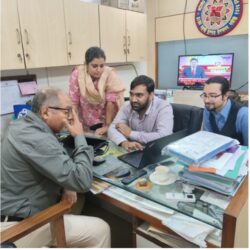
In addition to providing vital health information directly to women, e-SAATHI has developed dashboards with real-time data insights that are strengthening local health systems’ quality improvement efforts. The dashboards integrate data that AskNivi has captured related to every stage of the maternal health journey, including women’s interactions with wellness content, self-reported health-seeking patterns, and feedback on each facility visit. Comprehensive data enable e-SAATHI to predict maternal health trends and pinpoint instances where women’s utilization of services is lower than expected, triggering quick action to resolve challenges.
The dashboards have become essential tools for better understanding maternal care delivery in Assam. They are now used routinely in health administrators’ meetings and the insights are shared with facility or government officials, who then guide service providers to take appropriate action.
Considerations for health leaders
Digital health solutions and data-driven tools offer great promise for identifying and helping overcome gaps in access to timely, high-quality care. When used effectively, they have the power to strengthen health system service delivery, resilience, efficiency and efficacy. We urge health leaders to recognize the value of these technologies and consider the following recommendations to ensure that they reach their full potential.
- Identify health system gaps and encourage innovation to bridge them: Encourage and support rapid research and development of digital health technologies that are targeted at solving a specific problem or health system gap.
- Leverage data to drive health decisions: Promote transparency and more efficient resource allocation by aggregating insights from women, health providers and health facilities to inform key decisions about how to address areas of great need.
- Safeguard patient privacy and security: Implement robust data privacy and security measures to protect patient information and foster trust in the health care system.
- Encourage data interoperability: Establish standards and guidelines for data collection, documentation and sharing to facilitate the seamless flow of information between different health care providers and health systems to maximize the value of these data.
- Invest in private-public partnerships: Pursue collaborations involving government agencies, health facilities and the private sector, which has expertise in digital technology and data analytics, to design and implement data-driven solutions that will have the greatest impact on health services and health outcomes.
The coalitions at the core of the Strengthening Systems for Safer Childbirth initiative, like e-SAATHI and KQE, are building a body of evidence to demonstrate that digital technology can improve maternal health care, delivering substantial benefits for women, their families and communities. As country governments strive to strengthen health care systems and achieve the health-related Sustainable Development Goals, including reducing maternal mortality, they must prioritize harnessing the power of digital innovation to maximize impact.
Authors:
- Sieglinder Mghenyi, Head of Health System Strengthening, Jacaranda Health (Kenya Quality Ecosystem)
- Sowmya Ramesh, Executive Director, Population Council Institute (e-SAATHI)
- Iyadunni Olubode, Director of Nigeria Programs, MSD for Mothers
- Pompy Sridhar, Director of India Programs, MSD for Mothers
The activities in this publication were supported by funding from MSD, through its MSD for Mothers initiative and is/are the sole responsibility of the authors. MSD for Mothers is an initiative of Merck & Co., Inc., Rahway, NJ, USA.
